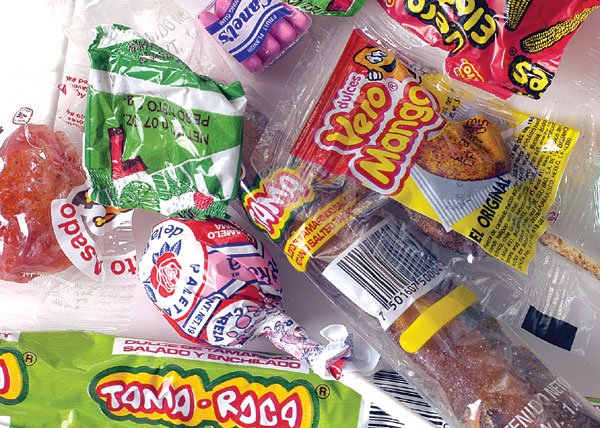County health department warns consumers after tests reveal high
lead content in Mexican candies
Gilroy – They come wrapped in colorful plastic packaging, the faint smell of sugar lingering on the outside. Burgundy chili powder coating the candies comes off on your fingers as you sift through a plastic bin at the local convenience store. Sometimes cartoon animals appear on the wrappers, inviting you to purchase the corn-syrup treats.
The ingredients appear on the packaging. But what is not mentioned is one critical detail: These Mexican candies may contain lead.
The Santa Clara County Public Health Department released a statement Wednesday warning consumers about two types of Mexican candy after random tests conducted by the California Department of Health Services revealed they may contain high levels of lead.
Pregnant women and children should not eat Dulmex Rollito De Tamarindo, a tamarind candy, or Vero Vagabundo, a lollipop with chili dipping powder, due to the health risks associated with ingesting lead, the study suggested.
“Lead is toxic to humans,” said Lea Brooks, a spokesperson for the CDHS. “It can cause brain damage.” Other problems include behavioral disorders, learning disabilities, memory loss, stomach pains, and in some cases – death.
“If you want to be safe, don’t eat Mexican candy,” Brooks said. “A lot of Mexican candy does fit within federal regulations, but over the years it has tested inconsistently.”
The Food and Drug Administration began testing Mexican candy in 1994 after lead was found in shipments of lollipops. Federal regulations limit candy sold in the United States to a maximum of .5 micrograms of lead per gram of product.
There are dozens of types of Mexican candies sold in California markets, and a FDA officer is not standing at the door monitoring the products sold over the counter.
About three years ago, a health inspector from the department of health visited Franco’s Imports in Gilroy and told owner Jose Franco he had to remove one of the candy products sold on his shelves because it contained lead.
An inspector has not been to his store in the past year to check for contaminated products, he said.
“I never get that kind here,” Franco said of the two candies recently listed by the CDHS.
He explained the difficulty knowing about all the Mexican candy products manufacturers sell.
“Sometimes, (they) bring it in and I don’t know,” he explained. “They don’t tell me what’s in them.”
Releases from the FDA and the CDHS are not sent to individual stores.
A spot check in four Gilroy stores including Franco’s Imports, Arteaga’s Super Save, Los Arcos Market and Super Save Market, found that while neither Dulmex Rollito De Tamarindo or Vero Vagabundo were on the shelves – 11 other candies that tested higher than the federal allowance of .5 ppm in lead content in previous state tests were.
Vero Mango and Vero Elotes were both tested in 1994 and resulted in an advisory from the state DHS. Both were found in all four stores. Vero Elotes were tested in 2004 and were within state regulation rates.
Tama Roca, a tamarind lollipop found to be high in lead content 20 percent of the time, was found in one store.
Limon 7, a square packet of powder that has tested about seven times the state guidelines in the past, was found in one store. In 2004, tests found the product to fit within state guidelines.
Canel’s gum, found in every store, have tested high about 25 percent of the time in the 13 tests since 1994. Most recent testing in 2004 found traces of lead, but were within regulation rates.
Tests are conducted at random and on candies imported from abroad and made in the United States.
Lead may be found in the candy or in its packaging system.
Many candies contain chili powder, which may be dried using lead gasoline, said Teresa Chagoya, spokesperson for the Santa Clara County Public Health Department.
The soil the chili is grown in may contain lead, or the chili may be ground in glazed pots where the glaze actually contains the mineral, and seeps into the candy. Lead is also sometimes found in the ink used on the wrappers.
Symptoms may not be visible so the only way to be certain a child has been exposed to lead is to perform a blood test. After the age of 2, children are no longer blood tested for lead unless a parent specifically requests it, Chagoya said.
Last year, 85 children developed lead poisoning in Santa Clara County – however, the exact cause is unknown since lead can still be found in paint, pottery and other exotic foods.
Following the latest round of testing in 2005, the Santa Clara County Health Department has embarked on a campaign in both English and Spanish to deliver the news, FDA spokesperson Janet McDonald said.
“Both California and the federal FDA have been working very closely with the manufacturers in Mexico and with the Mexican government to resolve this issue,” she said.
While the FDA regulates industry, it does not regulate retailers and cannot be searching every mom and pop shop that carries candy, McDonald explained.
“A lot of shipments that are coming in are not coming in commercially,” McDonald said. “There’s not a lot of regulatory control when they are brought over (by individuals for personal use.)”
Chagoya explained that there is not enough communication about the health risks and the testing found by the health departments, FDA and the vendors.
“There has not been real consistent programs that notify retailers,” she said. “We’re not sure if maybe they know … and if it’s a matter of economics – that it may be a popular candy so they keep it on the shelves. My guess is that they’re not getting the word.”













